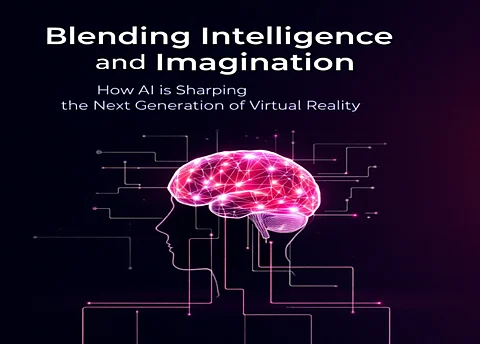

The contemporary period of digital transformation is when AI combines with VR to restructure how humans interface with digital environments. This field of exploration is taken to the utmost by Satya Krishna Kapil Tadikonda, who looks at how AI enhances the sensory, interactive, and cognitive dimensions of an experience in the virtual domain. With an enthralling grounding in immersive computing and adaptive systems, his work brings forth recent frameworks that possibly herald the prime evolution of virtual engagement.
Static environments and pre-scripted experiences once limited virtual reality. Today, AI is a dynamic partner, generating adaptive, user-responsive simulations. The integration begins with a foundational understanding of immersion, which goes beyond visuals to include auditory, tactile, and emotional dimensions. This convergence turns VR into more than a sensory trick—it becomes a cognitive ecosystem that reacts, evolves, and learns alongside its users.
Up to the present, it was all about individualistic, rigid, digital spaces. Here, through AI procedural content generation methods, an algorithmic recipe for an environment must be designed according to the preferences and behaviors of the user. Deep learning models such as GANs and VAEs generate landscapes that are seamless and ever-evolving. Experimenting with real-time scene adaptation opens up pathways for personalized experiences-the journey of every user is utterly different from another's.
There has been an introduction of deep learning-avatar synthesis, giving way to the very particular and expressive avatars of virtual identity. These avatars, through deep learning and computer vision, replicate how one looks, along with displaying facial emotions and user-attuned styles of communication: As one moves and acts in the real world, the avatars move and speak with the user, copying gestures, facial expressions, tones, and hues of behavioral nuances, thereby establishing an interactive and, one might say, lifelike construct. Such variations in tempo and gaze inconsistencies set to the feeling of embodiment—that is to say, embedding oneself into the experience—somewhat heightened; hence greater authenticity and immersiveness permeate the realm of virtual interactions. Keeping this in mind, there is evolution into an emotion-rich alibi wherein people get to consume much more GAI by interacting with presence and building up the higher-humanized feeling of being-with, clearly bringing an interface forward between physical and virtual reality.
By refining voice communication within a VR setting, NLP brings in natural, intuitive, and emotionally weighted interactions. Thanks to context-aware understanding, instant translation, and emotion recognition, an NLP application can allow free-flowing meaningful interaction with a virtual character or even with an actual person. The AI understands the meaning of words as well as voice tonality, intent, and emotional nuances. This capacity makes dialogue tremendously useful for enhanced narrative experiences, collaborative efforts, and emotional virtual interactions, all of which immensely enrich user engagement and reality.
By incorporating subtle cues like hand gestures, physiological stress indicators, and micro-expressions, sophisticated gesture and emotion recognition systems transform user interaction. Real-time analysis of these signals by AI models enables VR environments to dynamically adjust, changing the ambiance, plot, or reactions to correspond with the user's emotional state. This establishes a smooth, natural feedback loop in which the user and system have an impact on one another. This enhances emotional resonance and interactivity in digital environments by creating a natural, intimate, and highly engaging virtual experience that is sympathetic and immersive.
The combination of AI and VR for user-focused design uses advanced behavioral analysis and preference modeling to provide highly customized experiences. An AI system constructs a dynamic user profile evolving with time, considering the gaze, gestures, patterns of movement, and decision-making behaviors involved by the user. These profiles enable real-time adaptations that could include anticipating the means of interaction, adjusting difficulty, and modifying content. By anticipating needs and preferences and responding to the input of the user, the system creates an immersive environment that increases levels of engagement and satisfaction. This combination of AI and VR turns passive experiences into intelligent, adaptive ecosystems, tailored unambiguously for each individual andChanges the paradigm of interaction within virtual spaces.
From surgical simulations in healthcare to collaborative engineering models in industrial settings, AI-enhanced VR has transcended gaming and entertainment. In education, adaptive tutoring environments respond to each student’s learning curve. In therapy, environments adjust based on a patient’s biofeedback. Across all domains, AI-VR ecosystems are enabling new forms of skill development, collaboration, and treatment previously limited by real-world constraints.
The following are some of the challenges that remain even after some evolution. Scalability is limited by heavy computational requirements, system latency, and concerns about moral manipulation of users and user data. Some of these concerns have been alleviated with the advent of federated learning and model compression, but the way forward remains interdisciplinary. Along the lines of this, any future in the AI-VR intersection must really emphasize user agency, transparent information, and ethical design.
In conclusion, the research conducted by Satya Krishna Kapil Tadikonda interestingly paints a picture of a near-future where people reside in digital environments, not just inhabit experiences in them. By redefining the parameters of interaction, these intelligent, adaptable systems are leading us into the future in which the virtual is an extension of our emotional and cognitive selves rather than something separate from the real world.
